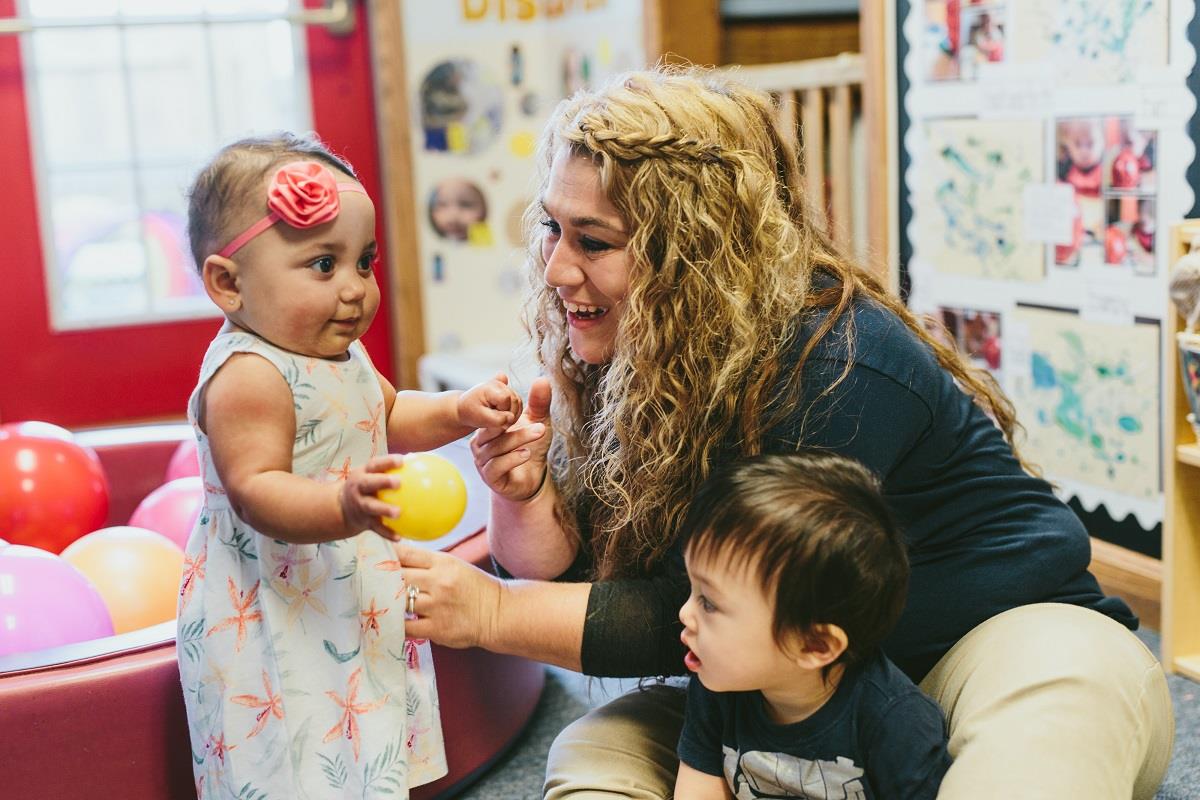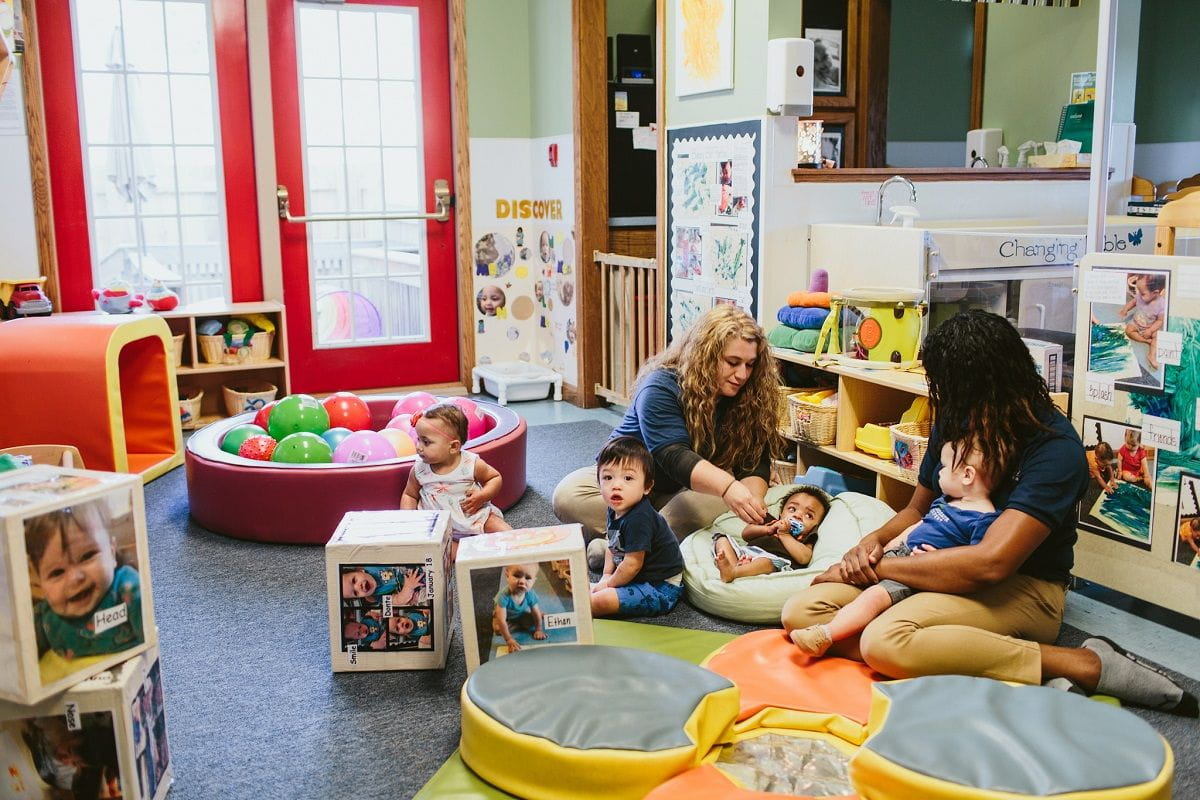Brightest Babies on the Block! 8 Ways to Build Baby Motor Development

“Babies are excited about every little thing—they can lose their minds with joy,” says award-winning infant teacher Regina Campisi. “I love this age!”
Teaching, nurturing, and caring for babies is Campisi’s professional mission. The veteran infant KinderCare educator in Macedonia, Ohio holds a bachelor’s degree in early childhood education (and her master’s degree is in the works).
So how does this expert infant educator make babies’ worlds a little brighter? “Parents can’t believe KinderCare follows a curriculum for infants,” Campisi says. “But every day, we incorporate fine motor activities because babies learn through their senses, and our activities are designed to support that process.”
What Is Sensory Development and Why Is It Important for Babies?
Babies begin sensory development in the womb. Once they’re in the big world, their five senses are fully functional and ready to touch, listen, see, taste, and smell their way through it. Babies’ brains can’t wait to take in new information, which is a crucial process. Why? Because neural connections are formed by building upon information that’s been previously processed. That’s why it’s so important to expose babies to lots of sensory stimulation, something that Campisi knows all about. Take a look at her favorite sensory-building activities!
1. Build Sensory Development with a Sensory Station
“Babies learn through their senses,” Campisi says. That’s why on one wall of her classroom, a collection of picture frames contains different textures (like sandpaper, bubble wrap, and silk) that are perfect for little fingers to touch and feel.
Try this at home: Keep a basket of sensory objects close at hand (but out of reach until you bring it out to explore). Take the above examples and add other pieces of fabric like felt, flannel, and fluffy faux fur. As your baby feels the different textures, talk to them! Not only will they love hearing the sound of your voice, but you can start to help them build associations for words like soft and rough.
2. Sing to Your Baby—A Lot
Research shows that singing is a powerful learning tool for babies. “Singing makes babies feel happy and safe,” says Campisi. “And when babies feel valued and safe and loved, you’re really giving them the very best start in life.”
Try this at home: Pick a bonding time (bedtime, bath time, diaper-changing, or nursing) and sing to your baby. You can even be silly and sing while you make meals.
3. A “Switch Board” Encourages Babies to Explore
Campisi created a board adorned with simple switches, door knobs, and bolts that babies can move around. “Babies love to move things back and forth and flip things up and down,” she says. Exploring with their hands helps babies build fine-motor skills—which they’ll need someday very soon for holding a spoon or a pencil!
4. She Chats with Babies—All Day Long
Whether she’s changing a diaper or giving a baby a bottle of breast milk, Campisi tells her infants what she’s doing. There’s an important reason for that: Talking to babies builds their understanding of language, helps them feel secure, and stimulates neural connections in their rapidly developing brains.
Try this at home: Even if it feels silly at first, describe what you’re doing, whether it’s washing dishes or giving your baby lots of snuggles. And know that it’s good to go “ga-ga, goo-goo,” when you do. The raised pitch, slowed syllables, and drawn out vowels of baby talk boosts their brain power.

5. She Helps Babies to Reach Farther
Helping babies reach their physical milestones is a big part of Campisi’s job—and she always encourages infants to try to reach those milestones on their own. To give them the confidence to, say, reach or crawl, she may place objects just out of reach of a baby’s grasp and encourage them to go for it!
Try this at home: “During tummy time, as long as they are happy, you might place a favorite toy just out of reach to encourage them to reach, grab, or move,” says Campisi. “That’s big work for them!”
6. Spice Jars Stimulate Their Sense of Smell
Campisi sometimes asks parents to bring in used spice containers. “The smell of nutmeg or thyme still lingers after the bottle is empty,” she says. “Babies will put it up to their mouth and nose and really explore it!”
Try this at home: Don’t throw out the spice jars until baby has had a little sniff. And yes, cute, nose-wrinkling smiles are inevitable.
7. She Responds to Babies’ Gurgles, Grunts, and Mumbles—Because that’s Their Way of Communicating
Just because babies can’t “talk” doesn’t mean they’re not talking! “Think of every sound they make as an invitation to communicate—and respond,” Campisi says. Research shows that serve and return—the back-and-forth communication between children and trusted adults—builds babies’ brain circuitry. It also helps them feel secure, because they know that there’s a loving adult right there to respond.
Try this at home: Acknowledge all those coos and cries, even if you’re up to your elbows in dishwashing suds trying to get something done while your baby plays in a nearby crib. A small response from you lets them know you’re there for them. And once those hands are dry, you can gather them up in your arms and have a real one-on-one.
8. She Also Nurtures Mothers—Because New Parents Need Love, Too
“Part of being a great infant teacher is being there for moms,” Campisi says, noting that the first year can be particularly hard for first-time moms. “Sometimes they just need to come in and cry—and I always provide that space. Sometimes they just need an empathetic person who understands.” Campisi, herself a mom of three, definitely gets it!
Try this at home: Take care of yourself! Get in the bath, go for a walk, do whatever you need to do to step away from parenting for a moment to give yourself needed attention. You’ll return to your sweet baby all the more able to give them the attention they need.




